This article was published June 1998 on the website of Pekiti Tirsia Europe:

Filipino Centennial
Pekiti-Tirsia Mastery Training Camp
- June 1998 -
After Grand Tuhon Gaje's successful seminar tour of Germany and Europe in May (more info here), Uli Weidle, the Managing Director of Pekiti-Tirsia Europe Organization, was delighted to accept his teacher Grand Tuhon Gaje's invitation and accompanied him back to the Philippines. In June, the Philippines was the venue for a series of momentous events, including the 100-year anniversary of the Filipino Revolution, the Pekiti-Tirsia Mastery Training Camp, the 1st Centennial Kali World Congress and the graduation of the Filipino Marines Force Recon Battalion.
Excerpts from Uli Weidles Travel Diary:
Private training and living with the Gaje-family
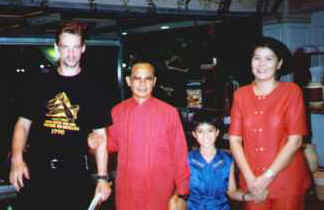
Because I arrived together with Grand Tuhon Gaje in the Philippines some weeks before the start of the Pekiti-Tirsia Mastery Training Camp I had the opportunity to live in the house of my teacher in Bacolod and to take part in the family life of the Gaje family.
In addition to extensive private practice with Grand Tuhon Leo T. Gaje, I had the privilege of meeting individuals who had direct interactions with the grandfather of Grand Tuhon Gaje, gaining invaluable insights into his character. Conrado B. Tortal, the Great Grand Tuhon of Pekiti-Tirsia Kali and grandfather of Grand Tuhon Gaje, was undoubtedly an impressive man. He was very educated, a strong fighter, full of energy and guided by strict moral principles. Discipline and respect were of the utmost importance to him. He was rooted in the old Filipino culture, as it is lived and taught by Grand Tuhon Gaje. There is no doubt that Great Grand Tuhon Conrado B. Tortal was a good man who helped poor people and supported the city. Furthermore, the descriptions about the challenge fights and the evening training were very interesting.
Training with Master Kolimbo
I was fortunate to have the chance to train with Master Kolimbo, a 69-year-old master. Master Kolimbo had previously stopped teaching as he was unable to find an individual with the required self-discipline to learn his system. However, Master Kolimbo was a friend of Grand Tuhon Gaje's father, and Grand Tuhon used his contacts to open Master Kolimbo to me, so that he would teach me.
Master Kolimbo teaches the Tapada system, which uses a stick about as long as the shoulder height made from the coffee tree. He also teaches Pangamut/Dumog (empty hands and Filipino combat wrestling). His specialty are the Pokol techniques (hammerfist). The Tapada-Stick is also used for conditioning, to develop the power, speed and braveness needed for empty hands combat. As soon as Gaje mentioned my background as a boxer, Master Kolimbo was thrilled. The 69-year-old man's eyes reflected the fighting fever, and he was eager to demonstrate the effectiveness of his system in actual combat. Master Kolimbo has plenty of experience in challenge fights. The dumogueros from the Kolimbos clan were the neighbourhood's protectors, keeping bullies and other bad elements at bay. Kolimbos' brother made his living by challenge fighting. The Kolimbo family's fighting system uses the same principles as Pekiti Tirsia Kali: no blocks, offence as defence, no static stances, finish at the first opportunity.
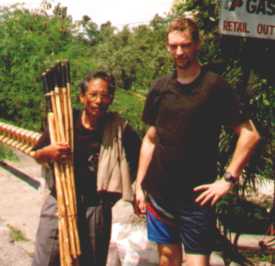
The Kolimbos family were extremely welcoming and friendly towards me. They exemplified the Filipino value of hospitality in its purest form. Kolimbo is a master of the old school, no doubt about it. He teaches in a simple and direct manner. He tests his students for their character and attitude towards combat while he is training them. Master Kolimbo is a tough teacher and learning from him is painful. He really strikes hard, whether empty-handed or with the stick. Every new technique and every mistake is felt long after practice. The students get a real fight experience. This is undoubtedly part of the test. The student must experience the pain of the strikes and remain in control of his emotions. Those with a hot temper or an impatient nature will not be able to learn the system. However, Master Kolimbo is willing to switch roles. When I had to demonstrate that I understood what he was teaching, he wasn't satisfied with me pulling the strikes or missing him shortly to avoid hurting him. He really wanted to feel that I understood. I had to dish out and receive strikes. Once again, I learned a lot from this type of practice.
Master Kolimbo is unwavering in his commitment to uphold his teaching principles. He would rather let the tradition die than water it down or make it "easier" to learn. That's why he doesn't teach his sons, who were not willing to endure this hard way of learning. Master Kolimbos' teaching method is an expression of his trust in his own system. He believes that a student who is intelligent and is practising seriously will be able to protect himself. I'm looking forward to my next meeting with this impressive man.
Centennial Celebration + Graduation of the Marines
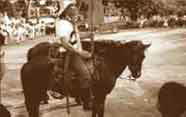
The whole country celebrated the Philippines' successful fight for freedom and the Centennial of 100 years of independence. Naturally, there were plenty of parades and fiestas. These celebrations were also held to honour the Kali fighters, who have been fighting to achieve independence. I was in Negros Occidental with Grand Tuhon Gaje when the Centennial Celebration took place. The Pekiti-Tirsia Kali Negros Group was also actively involved in a parade, as were groups representing the heroes of the Second World War and the current military. Every important group in the city participated in the parades and organised floats. It was inspiring to see these groups unite in one event.
The tradition of the Filipino Kali Fighters lives on to this day. Currently in the Philippines a special unit of the Filipino Marines, the Force Recon, is trained in Pekiti-Tirsia Kali to prepare them for Guerilla warfare and jungle combat. It is clear from experience that firearms are not sufficient for protection in guerrilla warfare in jungle or urban settings. Therefore, the Ginunting (a short sword) has been added to the Force Recon's equipment. The soldiers of the Force Recon are trained in the use of the Ginunting for close combat and in the methods of Pekiti-Tirsia Kali for countering disarming attempts (weapon retention) and for empty hands combat against knives. They are also trained in the strategies and tactics for empty hands close quarter combat against firearms.
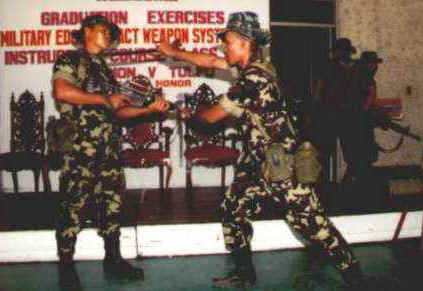
At the graduation ceremony of the Force Recon, I was the only non-Filipino (alongside Tim Waid, who oversaw the training) to witness and record the ceremony and demonstrations. I also had the privilege of speaking with the Commanding General of the Marines, who was in attendance. He was highly impressed by the Force Recon demonstrations and those of the guests.
1st Centennial Kali World Congress
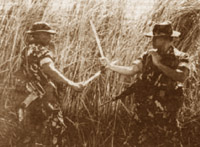
At the 1st Centennial Kali World Congress, the Pekiti-Tirsia Kali was named the official close-quarter combat art of the Marines. The President of the Philippines, the Commanding General of the Marines and Major Natalio Ecarta, the commanding officer of the Force Recon, delivered powerful messages that underscored the significance of the Kali World Congress. The Guard of Honour of the Marines provided a dignified setting. I attended the event as the official delegate representing Europe and was honoured to be seated in one of the places of honour alongside Philip Gelinas, who spoke on behalf of Canada, and Omar Hakim, who spoke on behalf of the USA. I was also delighted to be inducted into the PEKITI-TIRSIA KALI HALL OF FAME and awarded an honorary Hagibis, alongside other renowned Pekiti-Tirsia personalities.
Pekiti-Tirsia Mastery Training Camp
This training camp was attended by a number of well-known Pekiti-Tirsia and Kali practitioners. Marc Denny from California (the current chief of the Dog Brothers) was there, as was Philip Gelinas from Canada (one of the early students of Grand Tuhon Gaje and one of the founding members of the Dog Brothers). Also in attendance at the Mastery Training Camp were Omar Hakim, Jery Reyes (Police Detective from Erwin Ballertas group), Steve Raiter from the Inosanto Academy, Loki Jörgenson, Douc Marceida and many more. Also in attendance were Filipinos from various regions of the Philippines, as well as the Force Recon. Major Natalio Ecarma, the commanding officer of the Force Recon, was also participating in the training. I was the sole attendee from Europe.
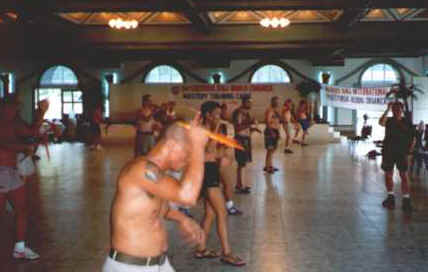
The training began as early as 4 a.m. and ended at 10 p.m. We underwent approximately 10 hours of training each day. The training covered the following main topics: We trained in Single Stick, Knife, Pangamot/Dumog (empty hands combat and combat wrestling), and Malay Sibat (combat with long pole, spear or bayonet). The training was conducted to the level of the Contra-Tirsia Dobla Doz system. Grand Tuhon Gaje demonstrated with unquestionable clarity how the fundamental principles of Pekiti-Tirsia are encompassed by the Contra-Tirsia Dobla Doz and how they are directly and effectively applied in practice. Grand Tuhon Gaje's teaching is focused on the essence, without unnecessary forms or other unnecessary distractions. Even long-time Pekiti-Tirsia practitioners benefited from training with Grand Tuhon Gaje, gaining new insights and understanding of the Pekiti-Tirsia System. Everyone was excited to train with Grand Tuhon Gaje.

After the first two days, I called the training camp the "training camp of the 500". Nobody believed at first in the 500 repetitions announced by Grand Tuhon Gaje. They were wrong. It became a standard, and some of the younger practitioners had to watch breathless how the 60-year-old Grand Tuhon Gaje demonstrated the last of the 500 repetitions. Grand Tuhon Gaje is as fit as always.
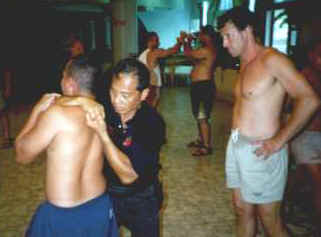
"Terminating" Fights
On the last day, there were Pekiti-Tirsia fights. Total Submission – Everything goes. As is customary in fights between advanced Pekiti-Tirsia fighters, there was only a minimum of protection gear: headgear and a single glove. All practitioners fought, despite minor injuries. The Marines also took part in the fights. The fighters used rattan sticks or wooden knives, without interference from the referee. Anything went, but there were surprisingly few serious injuries. Many fights ended with one opponent submitting. My fights went well. I wasn't seriously hit. I could deal out some good blows, and it was a good experience to successfully apply the techniques of Pangamot/Dumog I had trained.
The End ...
Despite the rigorous training, there were moments to enjoy the beach and the pleasant weather. To chat with other Kali enthusiasts or to relax at a boat trip.
Through the training camp I could forget the stress and all the problems of a manager – just dive into the martial art – that was a comfort to me. The fresh sea and air, the good food with lots of fresh fruit, fish, vegetable and poultry in combination with the training made me feel much younger. Now I can return to Europe with fresh energy.
Marc Denny will stay here a little longer and train together with Grand Tuhon Gaje. He has realized that Grand Tuhon is the original and has lots more to give
I am already looking forward to October, when I'll meet Grand Tuhon and my Filipino friends again. Then I will be in the company of my friends from Germany, Sweden, Switzerland and Luxembourg. We will have a wonderful time, as we always do.